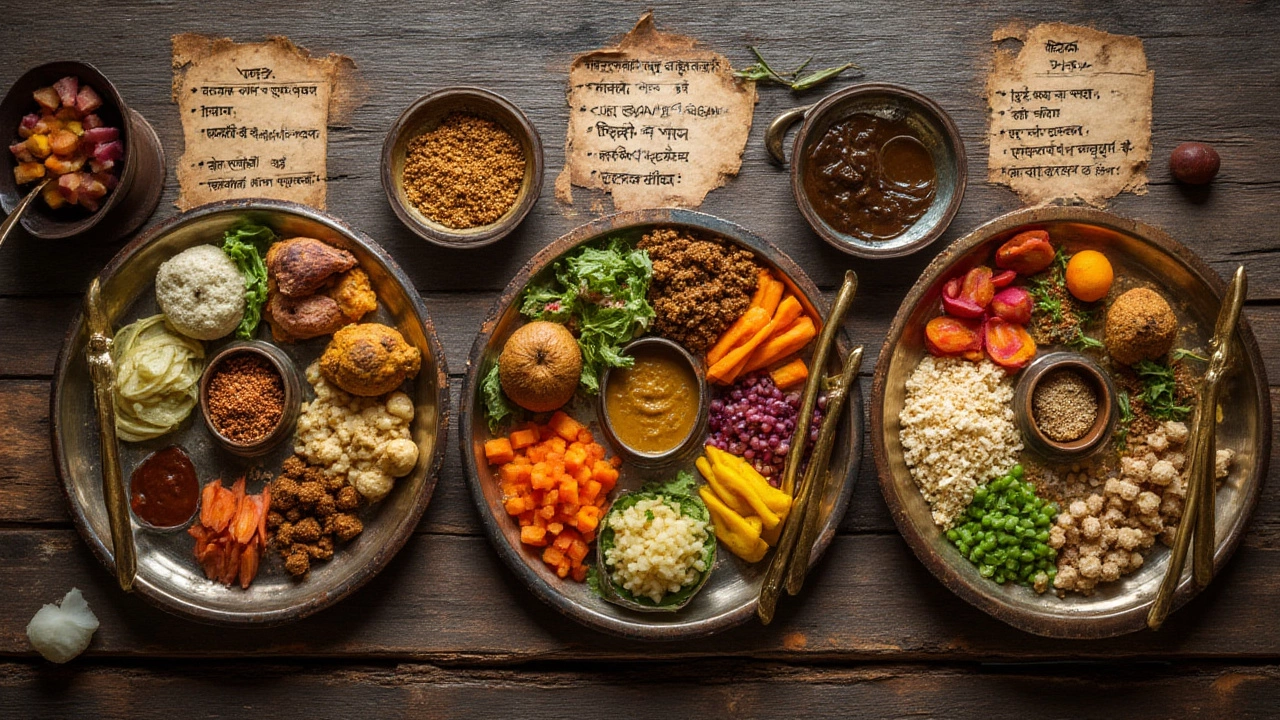Picture this—you feel out of sync for weeks, tired no matter how much sleep you get, or you’re stuck in a cycle of indigestion and cravings. Sounds familiar? That’s where the Ayurvedic diet steps in, an approach that isn’t just about what’s on your plate but how eating ties into every part of your life. Born from the more-than-3,000-year-old Indian system called Ayurveda, this diet promises more than weight loss or quick fixes. It’s about reading your unique self and eating in a way that calms, energizes, and truly nourishes. There’s a reason why yoga retreats serve kitchari, and why many folks swear by sipping hot ginger tea rather than reaching for a cold soda. The Ayurvedic diet is gaining fresh attention in 2025, as people seek natural balance amid screen-filled, hectic lives. And, even if you’re not in India or a devotee of yoga, its principles fit surprisingly well into daily routines.
How Does the Ayurvedic Diet Work? The Science and the Tradition
The core idea in Ayurveda is "balance." Think of your body as a system with its own personality—your physical traits, mind, and the way you react to stress or weather. According to Ayurveda, everyone is born with a specific blend of three doshas: Vata (air and space), Pitta (fire and water), and Kapha (earth and water). Each dosha brings its own set of characteristics, strengths, and challenges. Ever wondered why some folks wake up chirpy at dawn, while others are sluggish until noon? Or why your best friend sweats in winter while you’re always cold? Ayurveda says it’s all in your dosha mix.
The Ayurvedic diet isn’t one-size-fits-all. Food choices are based on your predominant dosha and the current season, since climate affects how your body handles digestion. If you want to know your dosha, you can take a quiz online or see a trained Ayurvedic practitioner. Usually, Vata types are thin and energetic but get cold easily; Pittas are muscular and driven, prone to heartburn; Kaphas are sturdy but can feel sluggish or gain weight easily. Ayurveda says you should eat opposites to balance your dominant dosha. For instance, Vata types (who tend to be dry and cool) do better with warm, moist, and grounding foods, while fiery Pittas benefit from cooling and less oily dishes.
Unlike calorie-counting diets, Ayurveda focuses more on qualities—taste (sweet, sour, salty, pungent, bitter, astringent), temperature, moisture, and how food feels in the body. The timing and setting of all meals matter too. Ayurveda believes your digestion is at its peak around midday when the sun is strongest, so lunch is your main meal. Eating on the go? That’s a no-go in Ayurveda. Meals should be eaten mindfully and preferably in a calm, distraction-free setting. Some studies, like a 2023 review from the National Institute for Ayurvedic Research, found that mindful eating alone can reduce overeating and improve mood—even without changing food types.
But does modern science back any of this up? Certain Ayurvedic principles echo what current nutrition research finds: whole foods, minimal processing, eating to your own hunger cues, and timing meals for best digestion. Still, clinical trials are scarce, and Ayurveda isn’t about quick experiments but long-term change. If you want hard proof, just look at the rates of digestive disease in traditional Indian villages—they’re far lower than in urban populations who’ve switched to processed Western diets.
| Dosha | Qualities | Best Foods | Foods to Avoid |
|---|---|---|---|
| Vata | Dry, light, cool, irregular | Warm grains, dairy, nuts, oily soups | Raw salads, cold drinks, dry snacks |
| Pitta | Hot, sharp, oily, intense | Cooling fruits, bitter greens, dairy | Spicy food, fried items, red meat |
| Kapha | Heavy, slow, cold, stable | Light grains, legumes, bitter veggies | Heavy dairy, sweets, fried food |

Making Ayurvedic Eating Simple: Practical Rules & Tips
Ayurvedic eating isn’t just for the health-obsessed or anyone with time to spare. You can fit its philosophy into busy lives, tight budgets, and picky taste buds. Here are some easy-to-try guidelines that can take you from just reading about Ayurveda to actually feeling its impact every day.
- Eat with the seasons. Ayurveda puts huge value on adjusting to weather. When it’s hot, fill your plate with cucumbers, sweet fruits, and leafy greens. When it’s chilly, think root veggies, soups, ghee, and spices that warm you up.
- Don’t skip meals, especially lunch. Your digestive fire, called agni, peaks midday. Try making lunch the largest meal with the most variety and have lighter dinners.
- Spice up your food. Spices aren’t just for flavor. Ginger, turmeric, cumin, fennel—these help your gut work better. One simple tip: Drink a cup of hot ginger tea 30 minutes before lunch if your digestion feels slow.
- Put down your phone while eating. Even a few minutes of mindful chewing can help your body absorb more nutrients and reset cravings.
- Eat freshly cooked meals when you can. Leftovers aren’t evil, but Ayurveda says the fresher, the better. If you must keep leftovers, heat them thoroughly and avoid eating cold straight from the fridge.
- Pair food thoughtfully. Ayurveda warns against mixing dairy with sour fruits or fish, as it can mess with digestion. Try to limit how many wildly different types of foods are on your plate at once.
- Don’t drink loads of cold water with your meals. Sip room temperature or warm water as needed, so you don’t douse your digestive fire.
- Listen to your body. Ayurveda says you should stop when you’re 75% full. You’ll avoid bloating and feel lighter.
Beyond all this, the Ayurvedic diet leans hard into vegetables, lentils, grains like rice or millet, moderate dairy, healthy fats like ghee, and lots of herbs and spices. You won’t find much wheat, refined sugar, or heavy meat. There’s flexibility—it’s not about cutting out all foods forever, just knowing what makes you feel better or worse based on your unique makeup. And there’s no need for expensive “superfoods” either. Even a basic meal of rice, lentil dal, and sauteed veggies with a dash of cumin fits Ayurvedic rules and is budget-friendly.
Many Indian grandmothers use Ayurvedic rules without labels: adding roasted cumin to yogurt for easier digestion, boiling milk with turmeric for immunity, or serving kichari (a mix of rice and lentils) when someone’s sick. Ayurveda also suggests “mono-diet” cleanses—eating something simple for a few days to give your guts a reset—but it’s wise to get advice before trying any intense diets, especially if you have chronic illness or special needs.
Ayurveda is big on the emotional side too. Stress, anger, rushing—these are recognized digestion-wreckers. That’s why meals are supposed to be relaxed, not wolfed down in cars or in front of emails. If you’ve noticed gut issues during tense days, Ayurveda would nod knowingly. Another quirky but practical tip: sitting cross-legged on the floor for meals improves your posture, slows you down, and helps digestion (just try it).

Ayurvedic Diet in Real Life: What to Expect and How to Start
If you’re curious what a real meal looks like, it’s not complicated or bland. Take breakfast: Vata types might enjoy warm oatmeal topped with stewed apples and ghee for grounding energy, while Pitta folks would do better with cool smoothies of coconut, mango, and mint. Kaphas may wake up better with spiced buckwheat pancakes and some ginger tea for a kick. For lunch, an ideal Ayuvedic-style thali (plate) would have dal, seasonal vegetables sauteed in spices, steamed rice, a small helping of fresh chutney, and maybe a glass of buttermilk. Notice the focus on balance—protein, carbs, healthy fats, and lots of flavor without heavy frying or sugar-laden desserts.
Many followers say that the Ayurvedic diet does more than fix the tummy. With time, it sparks energy, steadies moods, clears up skin, and helps with sugar cravings. It’s not a magic cure, but thanks to its focus on real, home-cooked food, and eating calmly, a lot of people find it more sustainable than diet trends that cut out whole food groups or rely on processed shakes. One tip if you’re new: don’t overhaul everything at once. Pick one meal to “Ayurvedify”—say, make breakfast a mindful, warm, and spiced meal for a week—and see how you feel.
The Ayurvedic diet isn't dogmatic or full of strict “rules.” It’s more like a compass, guiding you through waves of seasonal changes, moods, and the everyday stresses of modern life. If you slip up and eat cold pizza at midnight or plow through a bag of fries, Ayurveda doesn’t demand guilt. Just notice how it felt, and get curious about how you feel the next time you come back to warm, spiced, balanced meals. The journey is more important than perfect adherence.
| Meal | Suggested for Vata | Suggested for Pitta | Suggested for Kapha |
|---|---|---|---|
| Breakfast | Hot porridge with ghee | Coconut smoothie | Buckwheat pancakes with ginger |
| Lunch | Kitchari with root veggies | Barley salad with greens | Lentil soup with bitter greens |
| Dinner | Stews and soft-cooked grains | Grilled vegetables and rice | Steamed veggies and light grains |
So, is the Ayurvedic diet right for everyone? It fits best if you love routine, enjoy cooking, or want to feel truly connected to your food—and yourself. For those with medical issues or picky eaters at home, you can still sneak in Ayurvedic tips (think: using digestion-boosting spices or timing meals better). For the food-obsessed or home cooks wanting flavor, you won’t be bored by its diversity of herbs, spices, and fresh combinations. If you want a “quick fix” or get anxious about certain rules, it might take some adjustment—but there’s no pressure for perfection. Approach it like exploring a new neighborhood where every meal teaches you something about your own needs, and you’ll find the Ayurvedic path rewards curiosity and kindness as much as discipline.
When you next sit down to eat, notice: are you eating for your body, your mood, or just because the clock says so? Ayurveda argues that the best food is the one that fits this moment, this season, this unique you. Not a bad philosophy for food—and for life.










